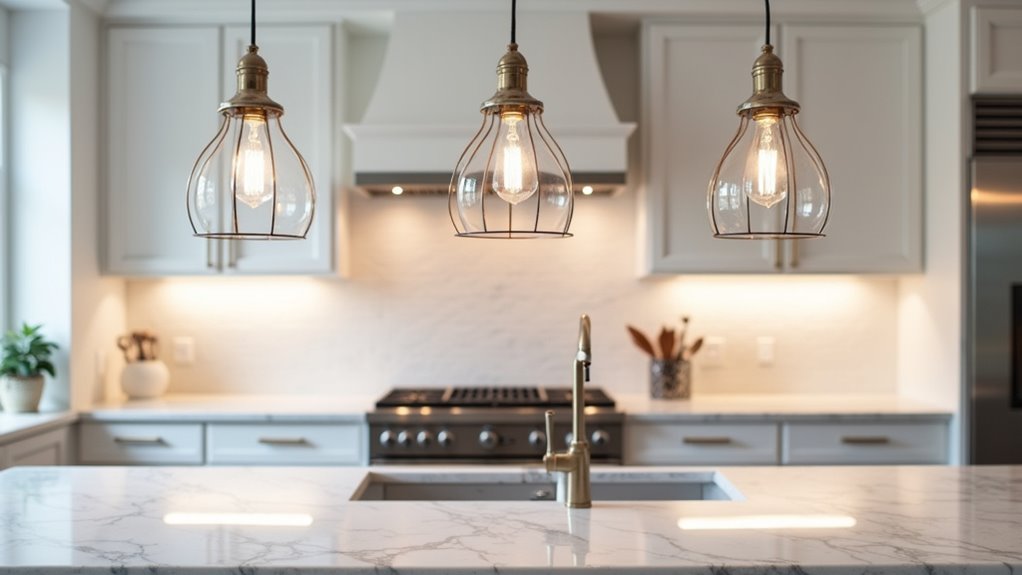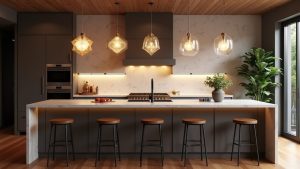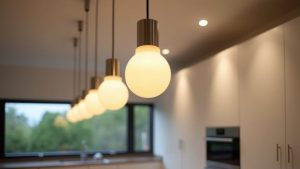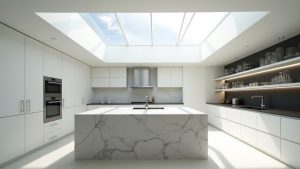Achieving the perfect height for kitchen pendant lights is crucial for both functionality and style. Standard guidelines suggest hanging pendants 30 to 36 inches above countertops, with adjustments for ceiling heights. Proper spacing of 24 to 30 inches apart is essential when using multiple pendants. Selecting the right size and considering room dynamics creates visual harmony. Balancing illumination and ensuring clearance enhances aesthetics and comfort. Exploring these guidelines further will lead to an impeccably designed kitchen lighting scheme.
Key Takeaways
- Hang pendant lights 30 to 36 inches above the kitchen island for optimal illumination and headroom.
- Space multiple pendants 24 to 30 inches apart for visual balance and effective lighting.
- Choose pendant sizes that are half to two-thirds the width of the kitchen island for proportional harmony.
- Ensure a minimum 7-foot clearance under pendants for safety and comfort in walkways.
- For larger islands, cluster three to five pendants in odd numbers to enhance focal interest and design.
Understand Standard Height Guidelines

When determining the optimal height for kitchen pendant lights, it is essential to grasp standard height guidelines that ensure both functionality and aesthetic appeal.
Typically, pendant lights should hang 30 to 36 inches above a kitchen island countertop, allowing for adequate headroom and unobstructed views. This height also facilitates focused task lighting for food preparation. Opting for energy-efficient LED bulbs in pendant lights can enhance ambiance while reducing overall utility costs. The recommended hanging height helps prevent accidental collisions while ensuring a comfortable atmosphere in the kitchen. Additionally, consider that the standard height for pendant lights should be adjusted based on the ceiling height to achieve the best results.
For multiple pendants, a general rule is to maintain spacing equal to the pendant’s diameter, ideally 30 inches apart to avoid overcrowding. Using flush-mounted lights is advantageous for kitchens with low ceilings, ensuring effective ambient lighting without obstruction from pendant fixtures.
The style of pendant, whether sleek modern or rustic charm, alongside its lighting finishes, can influence the visual balance and composition in the kitchen.
Adhering to these guidelines ensures optimal illumination without compromising aesthetics.
Adjust for Ceiling Height

When adjusting pendant light height, one must consider the unique attributes of the ceiling in the kitchen.
For standard 8-foot ceilings, pendants are typically hung 30 to 36 inches above the countertop; however, for every extra foot of ceiling height, an additional 2 to 3 inches should be factored in to maintain visual harmony.
This careful calibration ensures that the lighting complements both the space and its proportions, providing functionality without overwhelming the room.
Standard Height Guidelines
Although the ideal height for pendant lights is crucial for achieving both functionality and aesthetic appeal, it must be adapted based on the specific ceiling height of the kitchen.
For standard 8-foot ceilings, pendants should typically hang 30 to 36 inches above the countertop. This range varies, depending on pendant styles and personal preferences. Ensuring that the bottom of the fixture is 30 inches above the surface allows for focused task lighting while preventing obstructions in sightlines.
For ceilings exceeding 8 feet, extend the pendant’s cord by 3 inches for each additional foot. This adjustment ensures adequate illumination from diverse lighting materials, enhancing both visual balance and spaciousness in the kitchen environment while accommodating comfort and functionality.
Adjust for Extra Feet
Adjusting kitchen pendant light heights for ceilings taller than the standard 8 feet requires careful consideration to maintain both functionality and visual appeal.
The general rule suggests hanging pendants 30-36 inches above the countertop for 8-foot ceilings, with additional height considerations of 3 inches per extra foot of ceiling. For a 10-foot ceiling, this means pendants should be 36-42 inches above the surface.
Aesthetically, larger fixtures may need to increase in diameter and height by 10-20% to avoid feeling dwarfed in expansive spaces. Moreover, adequate cord or chain length is crucial; longer ceilings may require pendants to extend up to 6 feet.
Ultimately, achieving the right pendant adjustments ensures both effective lighting and harmonious kitchen design.
Properly Space Multiple Pendants

To achieve a harmonious and well-lit kitchen, spacing multiple pendant lights correctly requires careful consideration of both aesthetic and functional elements. Proper pendant arrangements should adhere to spacing guidelines, ensuring pendants are positioned 24-30 inches apart from center to center. For practicality, the distance between fixtures can also correlate with their width. Adding a moisture-resistant design from brands like Kichler or Allen+Roth can enhance durability, especially in areas prone to humidity. For larger islands, such as those ranging from 9-12 feet in length, utilizing three to five pendants can enhance visual appeal; an odd number often serves as a focal point. Incorporating cluster pendant lights can create visually dynamic designs and layered lighting effects while adding dramatic flair to the kitchen space.
Select Appropriate Pendant Size

Selecting the appropriate pendant size is crucial for creating a visually appealing and functional kitchen environment. The dimensions of the room significantly impact pendant styles; a general rule suggests that the sum of the room’s length and width in feet should translate to the pendant diameter in inches.
For kitchen islands, pendants should typically be half to two-thirds the surface width. Clearance must also be prioritized, ensuring at least 30-36 inches from the countertop to avoid obstructions.
For larger spaces with high ceilings, larger pendants are often recommended to maintain balance. When considering material choices, it’s essential to harmonize with the kitchen’s aesthetic, ensuring that the pendant not only fits proportionately but complements the overall design.
Consider Functional Lighting Needs

Choosing the right pendant size is only part of achieving the ideal kitchen lighting; functional lighting needs play a pivotal role in creating a well-lit workspace. Task-specific illumination is vital for kitchen activities like food preparation and cooking. Proper height—30-36 inches above countertops—ensures effective light while minimizing shadows. Headroom and sightlines are also crucial; a minimum of 7 feet clearance is recommended. The table below summarizes optimal pendant specifications:
| Activity | Ideal Height (inches) | Lumens Required |
|---|---|---|
| Food Preparation | 30-36 | 60-80 per sq. ft. |
| Over Sink | 40 | 40-60 per sq. ft. |
| General Lighting | 36-42 | Variable |
| Reading Recipes | 30-36 | 60-80 per sq. ft. |
Understanding these lighting functionalities ensures a well-balanced and effective kitchen environment.
Prioritize Design and Aesthetics

In the realm of kitchen design, the aesthetics of pendant lighting play a pivotal role in shaping the overall ambiance.
By selecting fixtures that complement the kitchen’s style and ensuring visual proportions are balanced, homeowners can create a cohesive and inviting environment.
Thoughtfully placed pendants not only highlight the room’s features but also enhance its atmosphere, making them a vital element in kitchen decor.
Complement Kitchen Style
A beautifully coordinated kitchen design can elevate a culinary space, and the right pendant lights play a pivotal role in achieving this harmony.
Selecting pendants that complement the kitchen’s overall aesthetics—be it modern, rustic, or traditional—sets the tone for the environment. Pendant styling should resonate with existing decor or serve as a striking contrast to heighten visual appeal.
It is essential to consider the materials and finishes of other elements like hardware and cabinetry, ensuring a cohesive look. For instance, glass pendants add an airy feel, while wooden designs introduce warmth.
Balance Visual Proportions
Harmonizing kitchen elements not only involves aesthetic alignment but also requires careful consideration of visual proportions. Successful pendant arrangements demand a thoughtful balance between size, spacing, and shape to achieve visual harmony.
The diameter of a pendant should typically be one-third to one-half the width of the island, while larger islands can accommodate oversized statement pieces. An odd number of pendants, according to the “rule of three,” often enhances visual interest. Spacing should be 24 to 30 inches apart, ensuring proper light coverage without crowding.
Moreover, selecting pendant shapes that complement the island’s configuration adds to the overall cohesion. By addressing these proportions, the kitchen can exude an inviting, balanced atmosphere, making each meal a delightful experience.
Enhance Room Atmosphere
While many elements contribute to a kitchen’s atmosphere, the choice and arrangement of pendant lights play a pivotal role in elevating both design and functionality.
The height of these fixtures significantly affects the room’s overall ambiance; lower hanging lights create a cozier, more intimate environment, while higher placements enhance an open, airy feel.
Utilizing various styles and materials in light layering can create striking ambiance contrast, inviting diverse moods for different occasions. For instance, a cluster of sleek metal pendants can anchor a contemporary design, while warm-toned bulbs offer a sense of comfort.
Maintain Clearances for Comfort

Clearances in kitchen design play a crucial role in maintaining comfort and functionality, especially when incorporating pendant lighting. The right heights and distances enhance ergonomic design, ensuring that comfort factors are addressed for everyone in the space. For optimal light during cooking, pendants should hang 30-36 inches above countertops, while those above dining areas should be maintained at a similar height for ease of use.
| Area | Minimum Clearance |
|---|---|
| Countertops | 30-36 inches above surface |
| Walkways | 7 feet from floor to bottom |
| Above doors | 6 inches above door frame |
| Seating areas | 5-7 feet above seat height |
These clearances help avoid distractions, promote interaction, and create an inviting atmosphere.
Use the Rule of Three for Balance

Strategically applying the Rule of Three can transform a kitchen space, offering both aesthetic appeal and functional coherence. This design principle emphasizes that grouping items in odd numbers, particularly threes, creates visual symmetry while promoting dynamic visual interest.
When arranging pendants over a kitchen island, three allows for a natural and harmonious appearance, making the space feel engaging rather than static. Ideally, one pendant should be centered, with the others evenly spaced about 30-32 inches apart, ensuring proportionality in the pendant arrangement.
For longer islands, three smaller pendants can maintain balance, while two larger fixtures could suffice in tighter spaces. This thoughtful arrangement fosters a rhythmic flow and visual balance, elevating the overall kitchen design.
Ensure Adequate Illumination

In the realm of kitchen design, adequate illumination is vital for creating an efficient workspace.
Task lighting, particularly over kitchen islands, must be positioned to provide clarity while minimizing shadows and glare, ensuring the chef can work without obstruction.
Task Lighting Importance
How crucial is adequate task lighting in the kitchen? Task lighting is essential for enhancing kitchen functionality, providing focused illumination on work surfaces where precise tasks like chopping and measuring occur.
Properly positioned fixtures—such as pendant lights above islands or under-cabinet lights—ensure safety by improving visibility and preventing accidents with sharp utensils or hot items.
Adequate lighting not only boosts efficiency, allowing for quicker meal preparations, but also reduces eye strain. A well-lit workspace transforms the kitchen into a practical and enjoyable environment.
With a recommended lux level between 500-750 for these areas, the correct task lighting allows culinary enthusiasts to navigate their kitchens with confidence and ease, emphasizing the importance of strategic lighting in every cooking endeavor.
Avoiding Shadows and Glare
Achieving the right balance of light in the kitchen is vital for both functionality and comfort, particularly when it comes to avoiding shadows and glare.
Proper pendant height, typically 30-36 inches above the countertop, facilitates optimal illumination while maintaining sightlines. Such positioning minimizes eye strain, with careful attention to lighting design preventing harsh glare and unwanted shadows.
Utilizing diffusing shades, like opal glass or translucent materials, aids in glare control, providing a soft glow that enhances the overall ambiance.
Furthermore, selecting pendants with a wider beam angle fosters shadow reduction, ensuring even light distribution across work surfaces.
Take Household Member Heights Into Account

Considering the diverse heights of household members is crucial when determining the ideal placement for kitchen pendant lights. Height considerations must take into account the tallest person in the household to avoid an uncomfortable environment.
For an average ceiling of 8 feet, pendants should hang between 30 to 36 inches above the countertop, adjusting higher for taller individuals. This elevation prevents head-bumping, ensuring that all members can navigate the space freely.
Additionally, the pendants should not obstruct line of sight across the kitchen island, providing task visibility without shadows. Testing different heights before finalizing placements can ensure everyone’s comfort and create an inviting kitchen atmosphere that balances aesthetics with practicality.






